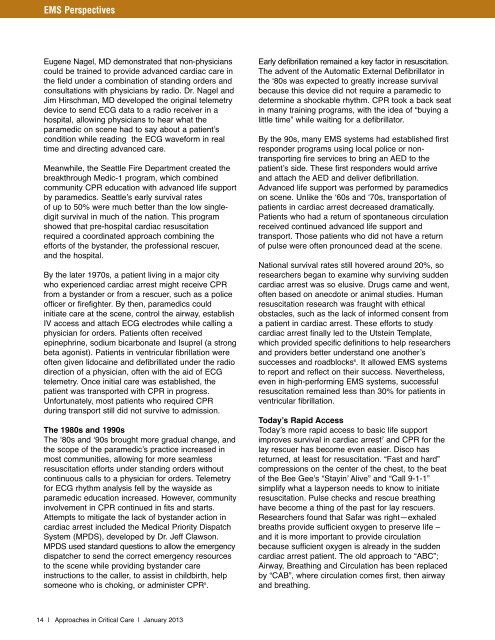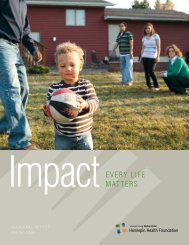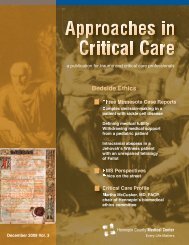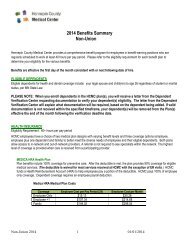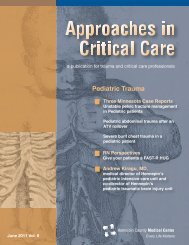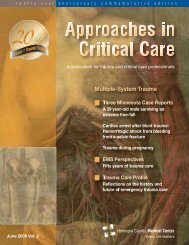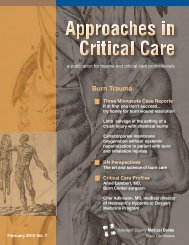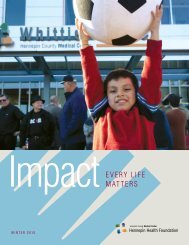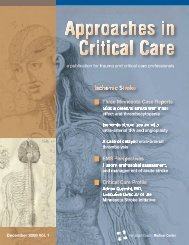HCMC_P_049062 - Hennepin County Medical Center
HCMC_P_049062 - Hennepin County Medical Center
HCMC_P_049062 - Hennepin County Medical Center
You also want an ePaper? Increase the reach of your titles
YUMPU automatically turns print PDFs into web optimized ePapers that Google loves.
EMS Perspectives<br />
Eugene Nagel, MD demonstrated that non-physicians<br />
could be trained to provide advanced cardiac care in<br />
the field under a combination of standing orders and<br />
consultations with physicians by radio. Dr. Nagel and<br />
Jim Hirschman, MD developed the original telemetry<br />
device to send ECG data to a radio receiver in a<br />
hospital, allowing physicians to hear what the<br />
paramedic on scene had to say about a patient’s<br />
condition while reading the ECG waveform in real<br />
time and directing advanced care.<br />
Meanwhile, the Seattle Fire Department created the<br />
breakthrough Medic-1 program, which combined<br />
community CPR education with advanced life support<br />
by paramedics. Seattle’s early survival rates<br />
of up to 50% were much better than the low singledigit<br />
survival in much of the nation. This program<br />
showed that pre-hospital cardiac resuscitation<br />
required a coordinated approach combining the<br />
efforts of the bystander, the professional rescuer,<br />
and the hospital.<br />
By the later 1970s, a patient living in a major city<br />
who experienced cardiac arrest might receive CPR<br />
from a bystander or from a rescuer, such as a police<br />
officer or firefighter. By then, paramedics could<br />
initiate care at the scene, control the airway, establish<br />
IV access and attach ECG electrodes while calling a<br />
physician for orders. Patients often received<br />
epinephrine, sodium bicarbonate and Isuprel (a strong<br />
beta agonist). Patients in ventricular fibrillation were<br />
often given lidocaine and defibrillated under the radio<br />
direction of a physician, often with the aid of ECG<br />
telemetry. Once initial care was established, the<br />
patient was transported with CPR in progress.<br />
Unfortunately, most patients who required CPR<br />
during transport still did not survive to admission.<br />
The 1980s and 1990s<br />
The ‘80s and ‘90s brought more gradual change, and<br />
the scope of the paramedic’s practice increased in<br />
most communities, allowing for more seamless<br />
resuscitation efforts under standing orders without<br />
continuous calls to a physician for orders. Telemetry<br />
for ECG rhythm analysis fell by the wayside as<br />
paramedic education increased. However, community<br />
involvement in CPR continued in fits and starts.<br />
Attempts to mitigate the lack of bystander action in<br />
cardiac arrest included the <strong>Medical</strong> Priority Dispatch<br />
System (MPDS), developed by Dr. Jeff Clawson.<br />
MPDS used standard questions to allow the emergency<br />
dispatcher to send the correct emergency resources<br />
to the scene while providing bystander care<br />
instructions to the caller, to assist in childbirth, help<br />
someone who is choking, or administer CPR 5 .<br />
Early defibrillation remained a key factor in resuscitation.<br />
The advent of the Automatic External Defibrillator in<br />
the ‘80s was expected to greatly increase survival<br />
because this device did not require a paramedic to<br />
determine a shockable rhythm. CPR took a back seat<br />
in many training programs, with the idea of “buying a<br />
little time” while waiting for a defibrillator.<br />
By the 90s, many EMS systems had established first<br />
responder programs using local police or nontransporting<br />
fire services to bring an AED to the<br />
patient’s side. These first responders would arrive<br />
and attach the AED and deliver defibrillation.<br />
Advanced life support was performed by paramedics<br />
on scene. Unlike the ‘60s and ‘70s, transportation of<br />
patients in cardiac arrest decreased dramatically.<br />
Patients who had a return of spontaneous circulation<br />
received continued advanced life support and<br />
transport. Those patients who did not have a return<br />
of pulse were often pronounced dead at the scene.<br />
National survival rates still hovered around 20%, so<br />
researchers began to examine why surviving sudden<br />
cardiac arrest was so elusive. Drugs came and went,<br />
often based on anecdote or animal studies. Human<br />
resuscitation research was fraught with ethical<br />
obstacles, such as the lack of informed consent from<br />
a patient in cardiac arrest. These efforts to study<br />
cardiac arrest finally led to the Utstein Template,<br />
which provided specific definitions to help researchers<br />
and providers better understand one another’s<br />
successes and roadblocks 6 . It allowed EMS systems<br />
to report and reflect on their success. Nevertheless,<br />
even in high-performing EMS systems, successful<br />
resuscitation remained less than 30% for patients in<br />
ventricular fibrillation.<br />
Today’s Rapid Access<br />
Today’s more rapid access to basic life support<br />
improves survival in cardiac arrest 7 and CPR for the<br />
lay rescuer has become even easier. Disco has<br />
returned, at least for resuscitation. “Fast and hard”<br />
compressions on the center of the chest, to the beat<br />
of the Bee Gee’s “Stayin’ Alive” and “Call 9-1-1”<br />
simplify what a layperson needs to know to initiate<br />
resuscitation. Pulse checks and rescue breathing<br />
have become a thing of the past for lay rescuers.<br />
Researchers found that Safar was right—exhaled<br />
breaths provide sufficient oxygen to preserve life –<br />
and it is more important to provide circulation<br />
because sufficient oxygen is already in the sudden<br />
cardiac arrest patient. The old approach to “ABC”;<br />
Airway, Breathing and Circulation has been replaced<br />
by “CAB”, where circulation comes first, then airway<br />
and breathing.<br />
14 | Approaches in Critical Care | January 2013


